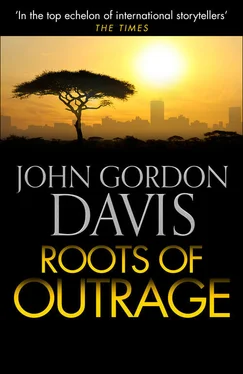ROOTS OF OUTRAGE
HarperCollins Publishers
1 London Bridge Street
London SE1 9GF
www.harpercollins.co.uk
First published in Great Britain by HarperCollins Publishers 1994
Copyright © John Gordon Davis 1994
Cover photograph © Shutterstock.com
John Gordon Davis asserts the moral right to be identified as the author of this work
A catalogue record for this book is available from the British Library
This novel is entirely a work of fiction. The names, characters and incidents portrayed in it are the work of the author’s imagination. Any resemblance to actual persons, living or dead, events or localities is entirely coincidental.
All rights reserved under International and Pan-American Copyright Conventions. By payment of the required fees, you have been granted the nonexclusive, nontransferable right to access and read the text of this e-book on-screen. No part of this text may be reproduced, transmitted, downloaded, decompiled, reverse-engineered, or stored in or introduced into any information storage and retrieval system, in any form or by any means, whether electronic or mechanical, now known or hereafter invented, without the express written permission of HarperCollins e-books.
HarperCollinsPublishers has made every reasonable effort to ensure that any picture content and written content in this ebook has been included or removed in accordance with the contractual and technological constraints in operation at the time of publication.
Source ISBN: 9780007574391
Ebook Edition © DECEMBER 2014 ISBN: 9780008119294
Version: 2014-12-16
‘John Gordon Davis has hit the jackpot again. Highly recommended … this epic volume cries out to be filmed.’
Natal Mercury
‘Captures perfectly the emotions, hopes and fears of a very explosive yet exciting time. It is a story so well told you can smell and feel Africa on every page.’
African Panorama
‘A sweeping history, politically questioning and charged with passion.’
The Star
‘Great holiday reading. This is a huge saga of history, politics, romance and adventure set against the turbulent background of South Africa.’
Eastern Province Herald
‘ North and South and Gone With the Wind wrapped into one. A great read.’
Sunday Tribune
This book is dedicated to my wife, Rosemary
The story of South Africa is real. The characters, with obvious exceptions, are fictitious.
Cover
Title Page
Copyright
Praise
Dedication
Epigraph
Maps
Prologue
Part I
Chapter 1
Chapter 2
Chapter 3
Chapter 4
Chapter 5
Part II
Chapter 6
Chapter 7
Chapter 8
Chapter 9
Chapter 10
Chapter 11
Part III
Chapter 12
Chapter 13
Chapter 14
Chapter 15
Chapter 16
Chapter 17
Chapter 18
Chapter 19
Chapter 20
Chapter 21
Chapter 22
Chapter 23
Chapter 24
Part IV
Chapter 25
Chapter 26
Chapter 27
Chapter 28
Part V
Chapter 29
Chapter 30
Chapter 31
Chapter 32
Chapter 33
Chapter 34
Chapter 35
Part VI
Chapter 36
Chapter 37
Chapter 38
Chapter 39
Chapter 40
Chapter 41
Chapter 42
Chapter 43
Chapter 44
Part VII
Chapter 45
Chapter 46
Chapter 47
Chapter 48
Chapter 49
Chapter 50
Chapter 51
Part VIII
Chapter 52
Chapter 53
Chapter 54
Chapter 55
Part IX
Chapter 56
Chapter 57
Part X
Chapter 58
Chapter 59
Chapter 60
Chapter 61
Chapter 62
Chapter 63
Part XI
Chapter 64
Chapter 65
Chapter 66
Chapter 67
Chapter 68
Chapter 69
Chapter 70
Chapter 71
Chapter 72
Chapter 73
Chapter 74
Chapter 75
Chapter 76
Chapter 77
Chapter 78
Chapter 79
Chapter 80
Chapter 81
Chapter 82
Chapter 83
Chapter 84
Part XII
Chapter 85
Chapter 86
Chapter 87
Chapter 88
Chapter 89
Part XIII
Chapter 90
Chapter 91
Chapter 92
Chapter 93
Chapter 94
Part XIV
Chapter 95
Chapter 96
Chapter 97
Chapter 98
Chapter 99
Chapter 100
Part XV
Chapter 101
Chapter 102
Chapter 103
Chapter 104
Chapter 105
Chapter 106
Part XVI
Chapter 107
Chapter 108
Chapter 109
Chapter 110
Chapter 111
Chapter 112
Part XVII
Chapter 113
Chapter 114
Part XVIII
Chapter 115
Chapter 116
Chapter 117
Chapter 118
Keep Reading
Acknowledgments
About the Author
Also by the Author
About the Publisher

Southern Africa at the Time of the Great Trek
South Africa at the time of the Boer War, 1899
(Modern names of provinces/countries are underlined)
The gallows stood ready, silhouetted. These hard, rolling hills of the eastern frontier of the Cape Colony were soaked in the blood of the Kaffir Wars, and today more blood was to be spilt at the execution of the five ringleader Boers of the Slagter’s Nek rebellion – at the very place where they had taken the oath to drive the British into the sea.
The hangman, who had journeyed up from the coast, had brought only enough rope to hang one man at a time, so the magistrate had acquired more, but unbeknownst to everybody it was rotten. Now five nooses dangled, and gathered around were the relatives of the condemned, the other rebels who had been sentenced to imprisonment and the Dutch farmers from miles around who had been ordered to attend to witness how seriously the British took rebellion. And now, from the direction of the military post, came the beat of drums, and the wagon bearing the condemned.
The drummers slow-marched. Slowly they advanced up the rise to the gallows. The condemned men climbed down off the wagon and mounted the scaffold. One after the other, the hangman tied their ankles, slipped the nooses over their necks. When all was ready, the Reverend Harold led the assembly in prayer. The magistrate ordered the drums to roll: softly, then louder and louder. The plank was kicked away, the men plunged into their death-fall, there came the dreadful wrench on their necks, and four of the ropes snapped.
The condemned men lay writhing in the dust, choking, as pandemonium broke out all around them: the shrieks of joy that the hand of God had intervened, people rushing to the struggling men, wrenching loose the nooses, the priest in the midst of them gabbling his prayers. Then the magistrate bellowed above the uproar: ‘Bring more ropes!
The uproar redoubled, the priest in the forefront – ‘God Himself has intervened!’ The magistrate had to shout at the top of his voice that it was not within his power to grant pardons.
By the time the horseman came galloping back with more ropes order had been restored. The condemned were clustered under the gallows in the arms of their wives and friends, surrounded by a ring of soldiers. While the hangman rigged new nooses the priest led the emotional people in prayer again. Then the condemned men sought permission to sing a hymn. This was granted, and the tearful cadence rose up. Then one of the condemned asked permission to say a few last words, and in a shaking voice he urged his brethren to heed his unhappy fate. They mounted the scaffold again. The magistrate ordered another roll of drums. The platform was kicked away.
Читать дальше













